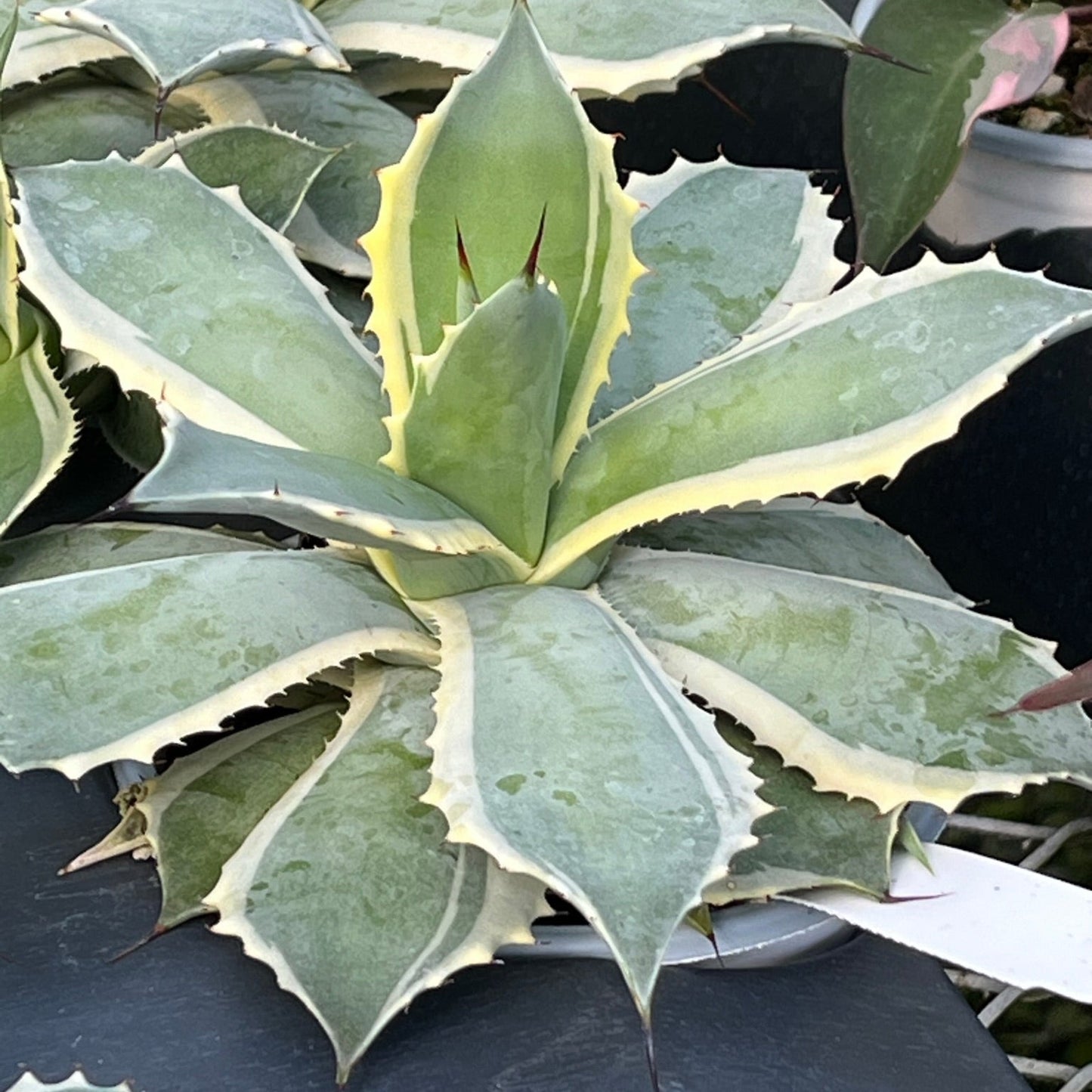Plant Hoarder
Agave, Blue Winds
Agave, Blue Winds
Couldn't load pickup availability
Share
Hardiness Zone:7, 8, and 9
Sun Exposure:Full Sun
Agave ‘Blue Winds’ — A Bold Beauty for Your Garden
If you’re looking for a plant that’s both striking and easy to care for, Agave ‘Blue Winds’ might be your perfect match. This bold, blue-gray succulent brings a sculptural elegance to any space. It’s not just a looker—it’s tough, drought-tolerant, and practically thrives on neglect. Let’s dive into what makes this agave so special, and how you can grow it like a pro.
🌿 What Is Agave ‘Blue Winds’?
Agave ‘Blue Winds’ is a large, fast-growing hybrid agave known for its broad, bluish leaves with gentle undulations along the edges. Unlike some agaves with sharp teeth or stiff leaves, ‘Blue Winds’ has a softer, more open form, making it more welcoming in the landscape. It can reach up to 5 feet tall and 6 feet wide, forming a dramatic, symmetrical rosette over time.
Its rich color and elegant shape add instant architecture to gardens, patios, or xeriscapes. And because it’s evergreen, it looks great all year long.
🌞 Where to Plant Agave ‘Blue Winds’
Location is everything when it comes to agaves. ‘Blue Winds’ loves:
-
Full sun to light shade: Give it at least 6 hours of sunlight a day. In very hot climates, a bit of afternoon shade can help prevent scorching.
-
Well-draining soil: This agave hates soggy roots. Sandy or rocky soil is ideal. Raised beds or mounds work great if your soil is heavy or clay-based.
-
Plenty of space: It’s a big agave! Leave room for it to spread out—don’t crowd it with other plants.
You can plant it in the ground in USDA zones 8b to 11. In colder areas, grow it in a large pot and move it to shelter during winter.
💧 Watering Tips: Less Is More
Here’s where ‘Blue Winds’ really shines: it’s low-maintenance.
-
After planting: Water deeply every 4–5 days for the first month while it establishes roots.
-
Once established: Cut back to every 2–3 weeks in warm weather. In cooler months, skip watering altogether unless it’s bone dry for long stretches.
-
Potted plants: Let the soil dry completely between waterings. Drainage holes are a must.
Overwatering is the biggest killer. If in doubt, don’t water!
🌡️ Temperature & Climate
Agave ‘Blue Winds’ is surprisingly cold-hardy for a large agave. It can survive temperatures down to 15–20°F (-9 to -6°C) once mature and well-established. But it does best with dry winters, so if you live in a cold, wet area, protect it from winter rain and frost.
In dry, desert climates? It thrives. In coastal zones? It thrives. It’s flexible—but hates sitting in cold, wet soil.
🌱 Soil Needs
This agave isn't fussy, as long as the soil drains well. You can:
-
Mix native soil with pumice, perlite, or coarse sand.
-
Use a cactus/succulent soil mix in containers.
-
Avoid compost-heavy or peat-rich mixes—they hold too much moisture.
Good drainage means happier roots—and a healthier, longer-living plant.
🪴 Container Growing
Want to enjoy ‘Blue Winds’ on a patio or balcony? No problem.
-
Choose a pot at least 18–24 inches wide with a drainage hole.
-
Use a light, gritty soil mix.
-
Water thoroughly, then let dry out completely.
-
Feed with a diluted cactus fertilizer 1–2 times per year during the growing season (spring and summer).
In winter, keep it dry and protect from hard frost by moving it indoors or under cover.
✂️ Maintenance & Growth Habit
This is the part you’ll love—almost no maintenance!
-
Leaves grow in a symmetrical rosette.
-
Old or damaged leaves can be snipped off cleanly near the base.
-
No pruning, no shaping, no fuss.
Over many years, Agave ‘Blue Winds’ may produce a tall flower spike, sometimes over 10 feet high! This event, called monocarpic blooming, happens just once in the plant’s lifetime. After flowering, the mother plant dies—but it often produces offsets (“pups”) around the base to keep the legacy alive.
You can replant those pups and keep the cycle going!
🦠 Pests and Problems
Good news—this agave is highly pest-resistant. But here are a few things to watch for:
-
Agave snout weevils in warmer regions. Keep an eye out for wilting or sudden collapse.
-
Root rot from too much water. Always check your drainage!
-
Sunburn in young plants if exposed to sudden, intense sun. Acclimate them slowly.
In general, a healthy, well-placed ‘Blue Winds’ is a plant-it-and-forget-it kind of beauty.
🌺 Design Tips
Agave ‘Blue Winds’ is more than a plant—it’s a statement piece. Here’s how you can show it off:
-
Anchor plant in xeriscapes: Pair with gravel, boulders, or ornamental grasses.
-
Bold contrast: Surround it with warm-colored succulents, golden sedums, or red kangaroo paws.
-
Modern container garden: Use it in a sleek ceramic or concrete planter.
-
Pollinator-friendly landscapes: When it blooms, hummingbirds will come in droves.
Its cool blue tones are calming and modern, and its shape draws the eye instantly.
🌵 Why Gardeners Love Agave ‘Blue Winds’
Let’s recap why this plant is winning over gardeners everywhere:
-
Dramatic form and color
-
Extremely drought-tolerant
-
Low-maintenance and pest-resistant
-
Tough but elegant
-
Cold-hardy for an agave
Whether you're new to gardening or a seasoned pro, Agave ‘Blue Winds’ brings success without stress. It teaches us that beauty doesn't always demand work. Sometimes, the boldest plant in the garden is also the easiest to grow.
So if you're dreaming of a landscape that stuns without a weekly chore list—this is your plant. Plant one, and let nature do the rest.


